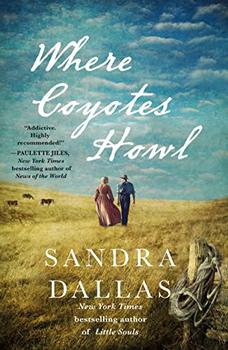Summary | Excerpt | Reading Guide | Reviews | Beyond the Book | Read-Alikes | Genres & Themes | Author Bio

This article relates to Where Coyotes Howl
 Where Coyotes Howl is set in the young and growing town of Wallace, Wyoming in 1916, following a couple named Ellen and Charlie's path as they set out to build a ranch on the High Plains. Author Sandra Dallas provides a slice-of-life picture of homesteading and ranching in Wyoming through the various characters. Many of Ellen's friends and neighbors are in different stages of settling their farms and ranches - with some scratching out a living subsistence farming while others have much more well-established farms and ranches.
Where Coyotes Howl is set in the young and growing town of Wallace, Wyoming in 1916, following a couple named Ellen and Charlie's path as they set out to build a ranch on the High Plains. Author Sandra Dallas provides a slice-of-life picture of homesteading and ranching in Wyoming through the various characters. Many of Ellen's friends and neighbors are in different stages of settling their farms and ranches - with some scratching out a living subsistence farming while others have much more well-established farms and ranches.
Life out West in the late 19th and early 20th centuries was extremely arduous due to the High Plains' low rainfall and extreme temperatures. Winters would give rise to sudden blizzards, with little to no visibility and below freezing temperatures, resulting in feet of snow that could trap people in their homes. One woman recalled a blizzard in 1888 where she was caught away from home at school and had to burn corn stalks and old chairs to stay warm. There was a lack of infrastructure and established basic institutions like hospitals and law enforcement. Accidents, injuries and illnesses that one might normally recover from with medical treatment could instead result in death. There were also numerous preventable deaths from complications during childbirth due to the lack of sufficient doctors and midwives. Without established law enforcement, crimes like murder and theft were not uncommon. Life was more difficult for women, particularly wives of farmers and ranchers, who would have to spend nine to eleven hours on chores.
Despite the difficulties in settling the land, numerous people still traveled out West, largely due to the Homestead Act of 1862, which granted 160 acres of free public land to people willing to work it. Between 25%-39% of the land in what is now Wyoming, the Dakotas, Montana, Colorado, Kansas and New Mexico was distributed through the Homestead Act — often after the forced removal of the Native populations living on those lands.
The Homestead Act presented a rare economic opportunity for women settlers — those who were single, widowed, divorced, or deserted by their husbands were eligible to receive land in their own names. This resulted in a boom of women homesteaders in the first two decades of the 20th century, with single women comprising about 20% of homesteaders. Famous women homesteaders like Willa Cather and Elinore Pruitt wrote about their experiences, drawing more women out West to seek economic freedom and growth. This developed a culture of independence and self-reliance, paving the road for the suffrage movement. It is no surprise that the Western states were the first to grant women the right to vote, as they had displayed grit and self-determination equal (at least) to their male counterparts.
Nebraska homesteaders the Chrisman sisters in 1886, courtesy of Nebraska History
Filed under People, Eras & Events
![]() This "beyond the book article" relates to Where Coyotes Howl. It originally ran in May 2023 and has been updated for the
April 2024 paperback edition.
Go to magazine.
This "beyond the book article" relates to Where Coyotes Howl. It originally ran in May 2023 and has been updated for the
April 2024 paperback edition.
Go to magazine.
Your guide toexceptional books
BookBrowse seeks out and recommends the best in contemporary fiction and nonfiction—books that not only engage and entertain but also deepen our understanding of ourselves and the world around us.